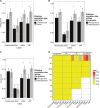Modeling the Multiple Facets of Speciation-with-Gene-Flow toward Inferring the Divergence History of Lake Whitefish Species Pairs (Coregonus clupeaformis)
- PMID: 28903535
- PMCID: PMC5737413
- DOI: 10.1093/gbe/evx150
Modeling the Multiple Facets of Speciation-with-Gene-Flow toward Inferring the Divergence History of Lake Whitefish Species Pairs (Coregonus clupeaformis)
Abstract
Parallel divergence across replicated species pairs occurring in similar environmental contrasts may arise through distinct evolutionary scenarios. Deciphering whether such parallelism actually reflects repeated parallel divergence driven by divergent selection or a single divergence event with subsequent gene flow needs to be ascertained. Reconstructing historical gene flow is therefore of fundamental interest to understand how demography and selection jointly shaped genomic divergence during speciation. Here, we use an extended modeling framework to explore the multiple facets of speciation-with-gene-flow with demo-genetic divergence models that capture both temporal and genomic variation in effective population size and migration rate. We investigate the divergence history of replicate sympatric species pairs of Lake Whitefish (normal benthic and dwarf limnetic) characterized by variable degrees of ecological divergence and reproductive isolation. Genome-wide SNPs were used to document the extent of genetic differentiation in each species pair, and 26 divergence models were fitted and compared with the unfolded joint allele frequency spectrum of each pair. We found evidence that a recent (circa 3,000-4,000 generations) asymmetrical secondary contact between expanding postglacial populations has accompanied Whitefish diversification. Our results suggest that heterogeneous genomic differentiation has emerged through the combined effects of linked selection generating variable rates of lineage sorting across the genome during geographical isolation, and heterogeneous introgression eroding divergence at different rates across the genome upon secondary contact. This study thus provides a new retrospective insight into the historical demographic and selective processes that shaped a continuum of divergence associated with ecological speciation.
Keywords: Coregonus; JAFS; demographic inference; ecological speciation; population genomics; speciation-with-gene-flow.
© The Author 2017. Published by Oxford University Press on behalf of the Society for Molecular Biology and Evolution.
Figures







Similar articles
-
The genetic architecture of reproductive isolation during speciation-with-gene-flow in lake whitefish species pairs assessed by RAD sequencing.Evolution. 2013 Sep;67(9):2483-97. doi: 10.1111/evo.12075. Epub 2013 Mar 9. Evolution. 2013. PMID: 24033162
-
Model-based demographic inference of introgression history in European whitefish species pairs'.J Evol Biol. 2019 Aug;32(8):806-817. doi: 10.1111/jeb.13482. Epub 2019 May 16. J Evol Biol. 2019. PMID: 31038776
-
Targeted sequence capture and resequencing implies a predominant role of regulatory regions in the divergence of a sympatric lake whitefish species pair (Coregonus clupeaformis).Mol Ecol. 2013 Oct;22(19):4896-914. doi: 10.1111/mec.12447. Epub 2013 Aug 21. Mol Ecol. 2013. PMID: 23962219
-
On the origin of species: insights from the ecological genomics of lake whitefish.Philos Trans R Soc Lond B Biol Sci. 2010 Jun 12;365(1547):1783-800. doi: 10.1098/rstb.2009.0274. Philos Trans R Soc Lond B Biol Sci. 2010. PMID: 20439281 Free PMC article. Review.
-
Environmental correlates of adaptive diversification in postglacial freshwater fishes.J Fish Biol. 2024 Mar;104(3):517-535. doi: 10.1111/jfb.15621. Epub 2023 Dec 10. J Fish Biol. 2024. PMID: 37984834 Review.
Cited by
-
Origin of the Laurentian Great Lakes fish fauna through upward adaptive radiation cascade prior to the Last Glacial Maximum.Commun Biol. 2024 Aug 12;7(1):978. doi: 10.1038/s42003-024-06503-z. Commun Biol. 2024. PMID: 39134631 Free PMC article.
-
The wild species genome ancestry of domestic chickens.BMC Biol. 2020 Feb 12;18(1):13. doi: 10.1186/s12915-020-0738-1. BMC Biol. 2020. PMID: 32050971 Free PMC article.
-
Widespread Deviant Patterns of Heterozygosity in Whole-Genome Sequencing Due to Autopolyploidy, Repeated Elements, and Duplication.Genome Biol Evol. 2023 Dec 1;15(12):evad229. doi: 10.1093/gbe/evad229. Genome Biol Evol. 2023. PMID: 38085037 Free PMC article.
-
Comparative genomics approach to evolutionary process connectivity.Evol Appl. 2020 May 1;13(6):1320-1334. doi: 10.1111/eva.12978. eCollection 2020 Jul. Evol Appl. 2020. PMID: 32684961 Free PMC article.
-
Selection and isolation define a heterogeneous divergence landscape between hybridizing Heliconius butterflies.Evolution. 2021 Sep;75(9):2251-2268. doi: 10.1111/evo.14272. Epub 2021 Jun 6. Evolution. 2021. PMID: 34019308 Free PMC article.
References
-
- Ambrose SH. 1998. Late Pleistocene human population bottlenecks, volcanic winter, and differentiation of modern humans. J Hum Evol. 34(6):623–651. - PubMed
-
- Amundsen P-A, Bøhn T, Våga GH.. 2004. Gill raker morphology and feeding ecology of two sympatric morphs of European whitefish (Coregonus lavaretus). Ann Zool Fennici 41:291–300.
-
- Aoki K, Kato M, Murakami N.. 2008. Glacial bottleneck and postglacial recolonization of a seed parasitic weevil, Curculio hilgendorfi, inferred from mitochondrial DNA variation. Mol Ecol. 17(14):3276–3289. - PubMed
-
- April J, Hanner RH, Dion-Côté A-M, Bernatchez L.. 2013. Glacial cycles as an allopatric speciation pump in north-eastern American freshwater fishes. Mol Ecol. 22(2):409–422. - PubMed
Publication types
MeSH terms
LinkOut - more resources
Full Text Sources
Other Literature Sources

